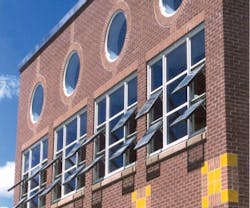Think noise – the whoosh of wind, the rush and roar of trains, planes, and automobiles.
It’s a problem that has derailed more than one attempt to naturally ventilate buildings, despite research that shows fresh air can reduce energy consumption, improve worker productivity, and dispel pollutants.
One issue is cost, given that extensive noise mitigation can diminish the energy savings associated with naturally ventilated buildings. Another is standards – or a lack thereof. Although most acoustical designers agree that higher background noise levels should be allowed in naturally ventilated buildings, international standards generally assume that buildings are sealed and air conditioned in order to meet recommended indoor noise levels, according to Chris Field, former principal acoustic consultant in the San Francisco office of consulting engineer Arup.
Field, who has studied the topic extensively, contends that occupants subjected to controlled levels of outdoor noise may eventually adapt to it, particularly if they anticipate the noise and enjoy the non-acoustic benefits of natural ventilation. Some studies that he cites suggest that internal noise levels of up to 65 dBA may be acceptable in naturally ventilated buildings.
For reasons of work efficiency and speech intelligibility, schools aren't among them, says Kenric Van Wyck, president of Grand Rapids, MI-based consultant Acoustics by Design. LEED standards limit noise levels in schools to 45 dBA.
The mid-frequency noise associated with aircraft, automobiles, and trains is particularly problematic because it closely matches the frequencies associated with human speech, thus compromising speech intelligibility.
Trains and automobiles are generally an issue in applications involving cross ventilation, a method relying on high- and low-pressure zones created by wind, because this approach calls for multiple openings in the curtainwall, says Erik J. Ryerson, senior associate with Chicago-based acoustical consultant Shen Milsom Wilke. "The greater the number of openings, and the greater the proximity to noise, the more likely it is that the building is going to encounter problems," he says.
Aircraft can cause problems in applications involving stack ventilation, a method relying on rising heat to create high- and low-pressure zones, since air is expelled through an opening in the roof.
While every building is unique due to proximity to airports, highways, urban thoroughfares, and other sources of noise, there are common methods to contend with acoustical problems in naturally ventilated buildings.
Hybrid Ventilation
According to Ryerson, many owners opt for hybrid – or mixed mode – systems that alternately rely on natural ventilation and mechanically assisted ventilation, depending on the season or exterior noise levels.
Labyrinths, Lined Elbows, and Silencers
Located near air inlets, labyrinths are lined with fiberglass or other materials that absorb sound energy, says Van Wyck. The problem is that they may reduce air flow so much that traditional fans are required to overcome air resistance, circumstances that prompt greater energy consumption.
Trickle Ventilators
Located in window frames or other components of the envelope, trickle ventilators – so named for reducing airflow to a trickle – are small, operable devices that facilitate both natural ventilation and noise attenuation when windows and other openings are closed. Consult with the mechanical engineer to ensure corresponding pressure drops meet minimal airflow requirements as recommended by ASHRAE Standard 62.
Soundmasking
As facility managers know, soundmasking introduces white noise to interior environments in order to promote speech privacy. Assuming natural ventilation results in little, if any, externally generated background noise, a masking system may be required in open offices and similar environments that promote natural ventilation.
U.S. literature remains thin on the topic of natural ventilation and acoustical design. The reason: U.S. owners and operators aren’t convinced they can meet air-exchange requirements as handily with natural ventilation as with conventional methods, says Van Wyck.
John Gregerson is a contributing editor writing from Chicago.
